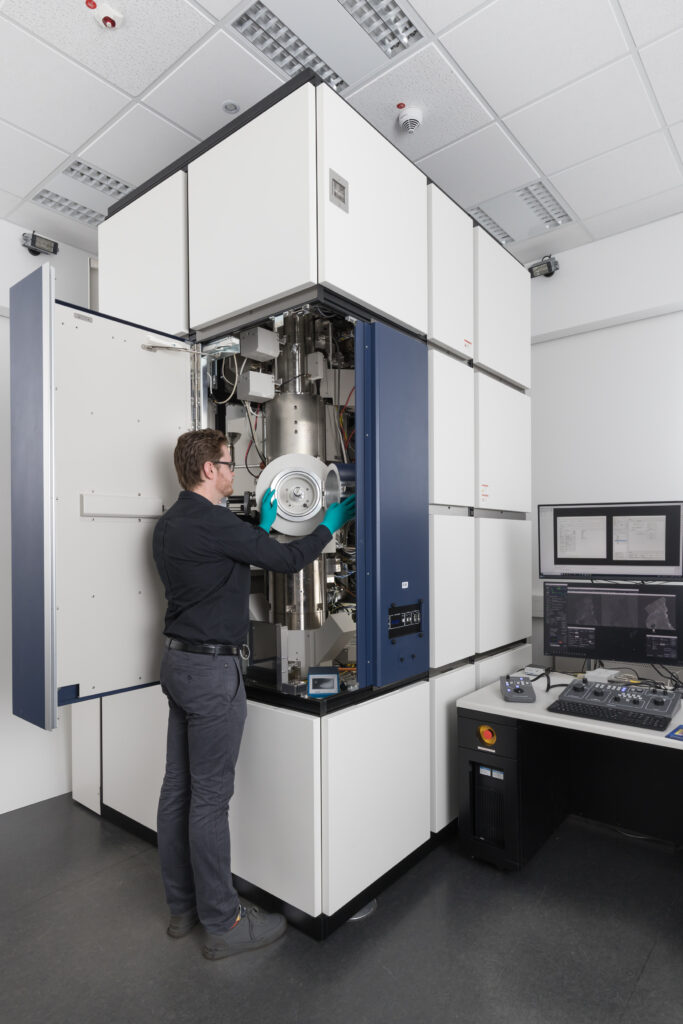Hitachi HF5000

The Hitachi HF5000 is a (scanning) transmission electron microscope designed to unravel solid-state phenomena at the atomic scale. By combining high special resolution and analytical capabilities with a gas inlet system and a variety of in situ holders, structural and compositional changes of a broad range of materials can be revealed at the atomic level. The system is equipped with a cold field emission electron gun, a Cs probe corrector (Hitachi), an energy dispersive spectroscopy unit (Oxford Instruments Aztec Energy TEM Advanced EDX System Ultim TLE), a post-column energy filter system (CEOS CEFID), and a TVIPS TemCam XF416 camera. Data acquisition is enabled by on-axis dark field, as well as bright field detectors, and a CCD camera. The examination of the sample surface can be carried out by means of a secondary electron detector. To enable energy-filtered 4D STEM measurements, the microscope is equipped with a segmented detector. The microscope can be remotely operated to maintain stable conditions during the experiments. Typical examples of use and technical specifications for the instrument are given below.
Sample Environment
In the standard setup samples are investigated at room temperature and at a vacuum level of about 10–8 mbar. For heating experiments Hitachi single and double tilt holders are available. By means of a gas mixing station, different gases (nitrogen, oxygen, synth. air, CO2 and hydrogen) and their mixtures can be introduced directly into the column at a maximum pressure of 16 Pascal. A Hitachi in situ liquid cell holder is available for electrochemical experiments. This holder is completed by a vacuum test station, a syringe dosing pump, a potentiostat and various MEMS chips with different electrode geometries.
Typical Applications and Limitations of Use
The capabilities of the Hitachi HF5000 allow a variety of different materials to be examined using a wide range of different electron microscopic techniques. In addition to high resolution scanning transmission electron microscopy with annular detectors for bright field, dark field and high angle annular dark field analysis, materials can be studied using electron energy loss spectroscopy, energy dispersive X-ray spectroscopy, electron tomography, momentum resolved scanning transmission electron microscopy, and a combination of the techniques listed. The instrument also has excellent resolution at low accelerating voltages, allowing characterization of beam sensitive samples. Coupled with the excellent structural and chemical analysis capabilities, this microscope is an ideal tool in the field of materials science and fundamental research.
The Hitachi HF5000 is not intended for the investigation of aqueous, contaminated, ferromagnetic or organic samples without further discussion with both, the instrument officers and the ER-C general management.
Technical Specifications
| Electron acceleration voltage | 60 kV … 200 kV |
| Point resolution (TEM) @ 200 kV | 102 pm |
| Resolution (STEM) @ 200 kV and 100 pA | < 78 pm |
| EDX system energy resolution (10 kcps) | < 72 eV |
| EDX solid angle | 2 sr |
| EELS system energy resolution @200 kV | 0.4 eV |
Detectors
| large-size CMOS detector XF416 4k x 4k (15.5 µm pixel size) | TVIPS |
| CEFID spectrometer with 2 and 5 mm entrance apertures | CEOS |
| Medium angle BF/DF STEM detectors | Hitachi |
| HAADF detector | Hitachi |
| Secondary electron detector | Hitachi |
| MerlinEM Direct Electron Detector (DED) | QuantumDetectors |
| AztecEnergy (EDS System) with 2 Ultim Max TLE detectors | Oxford Instruments |
Specimen Stages
| double tilt low background holder | ± 25 ° |
| high field of view single tilt tomography holder | ± 70 ° |
| Single and double tilt heating holder | ± 25 ° |
| In situ MEMS based liquid cell electrochemistry holder | 0 ° |
Instrument related Publications
| Häusler, J.; Pasel, J.; Woltmann, F.; Everwand, A.; Meledina, M.; Valencia, H.; Lipińska-Chwałek, M.; Mayer, J.; Peters, R. Elucidating the Influence of the d-Band Center on the Synthesis of Isobutanol. Catalysts 2021, 11, 406. https://doi.org/10.3390/catal11030406 |
| Díez, A.M.; Valencia, H.E.; Meledina, M.; Mayer, J.; Kolen’ko, Y.V. Photocatalytic-Fenton Process under Simulated Solar Radiation Promoted by a Suitable Catalyst Selection. Catalysts 2021, 11, 885. https://doi.org/10.3390/catal11080885 |
